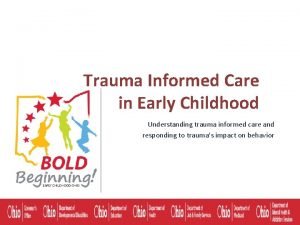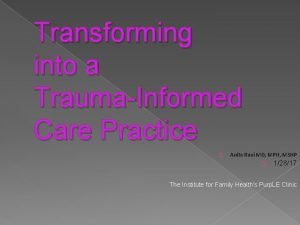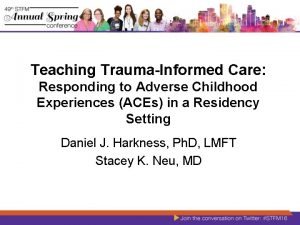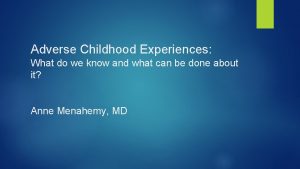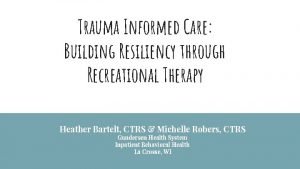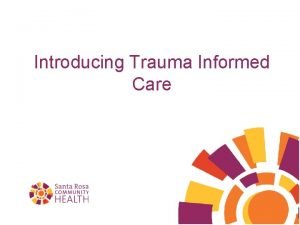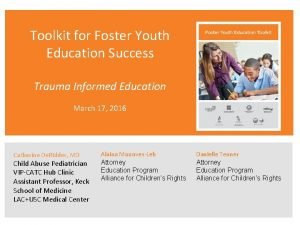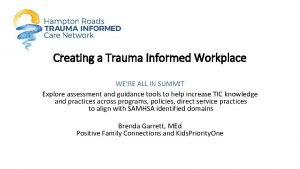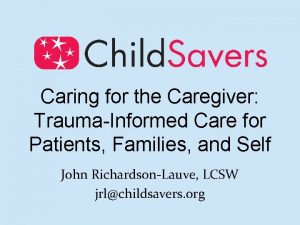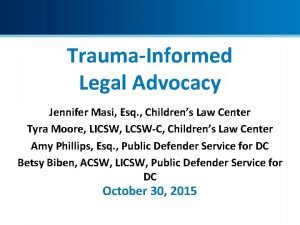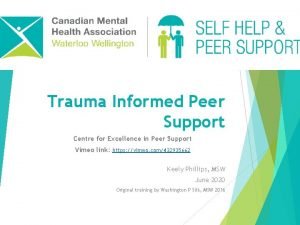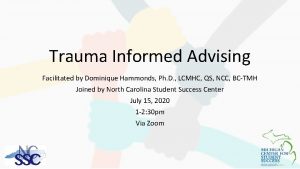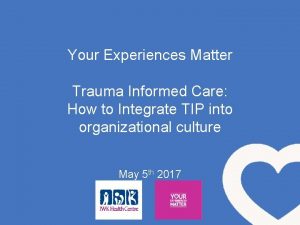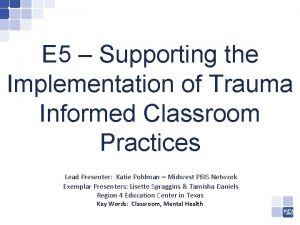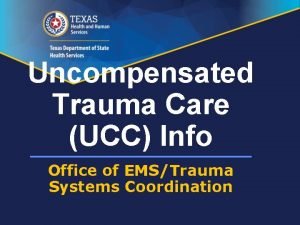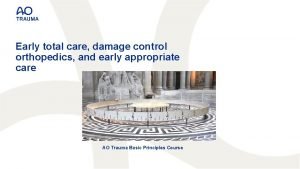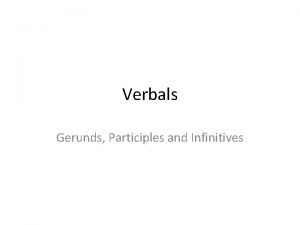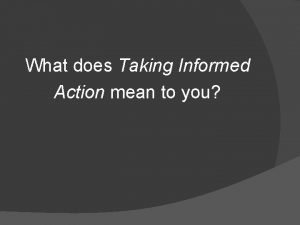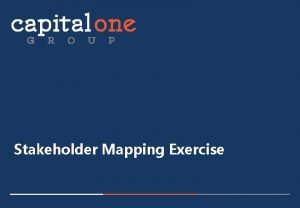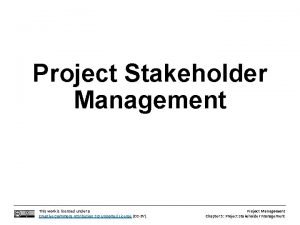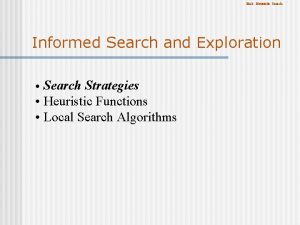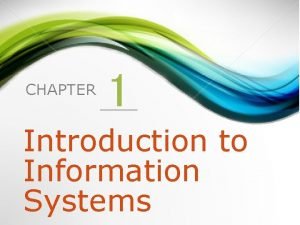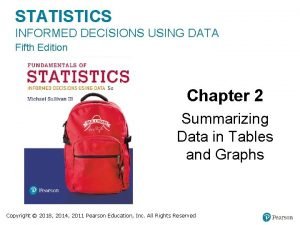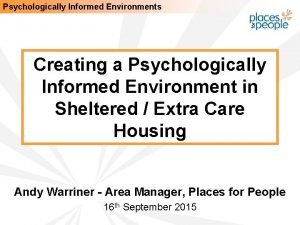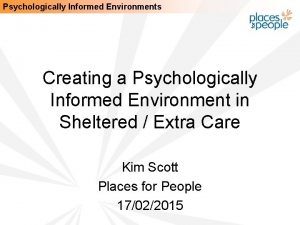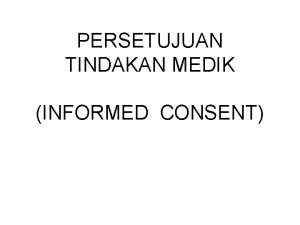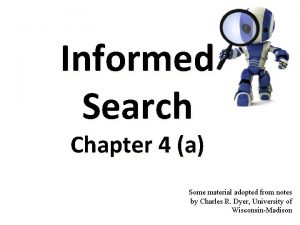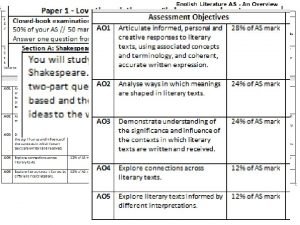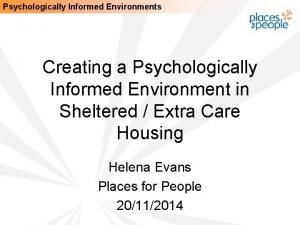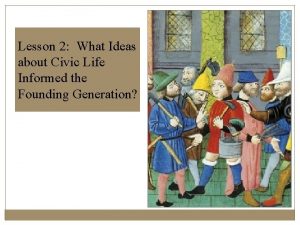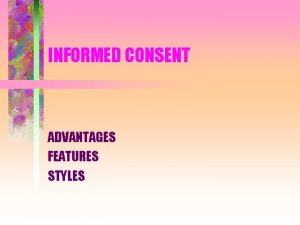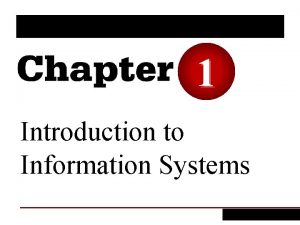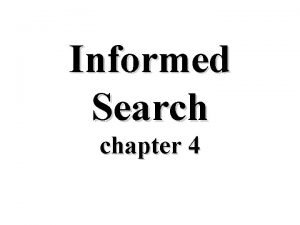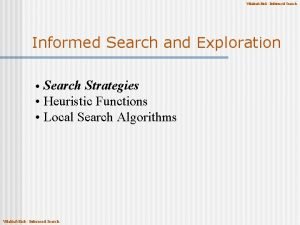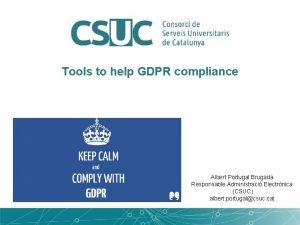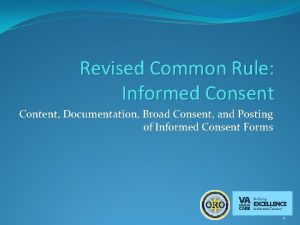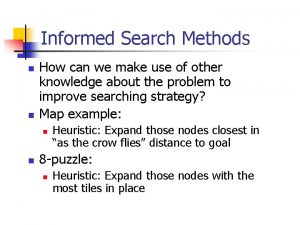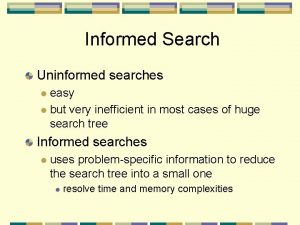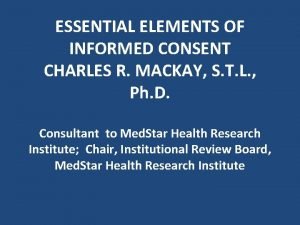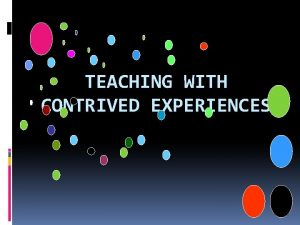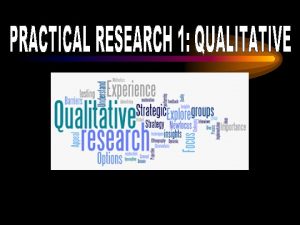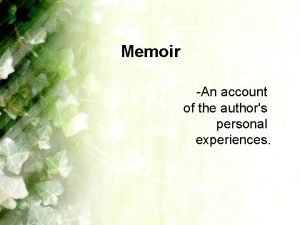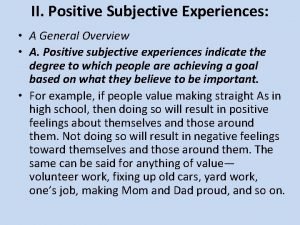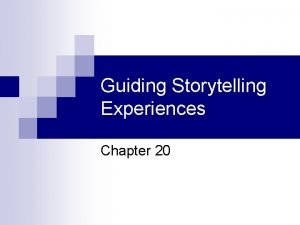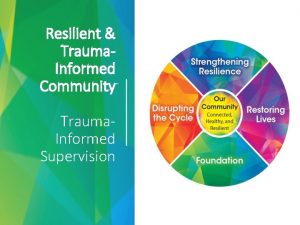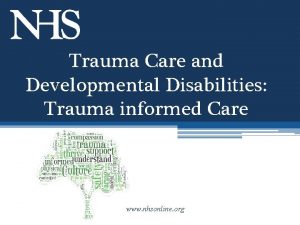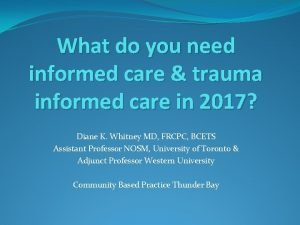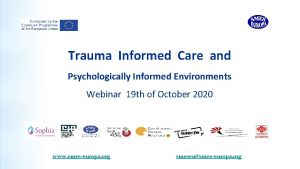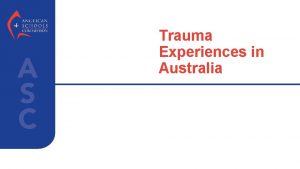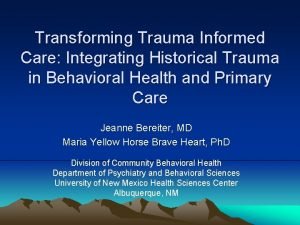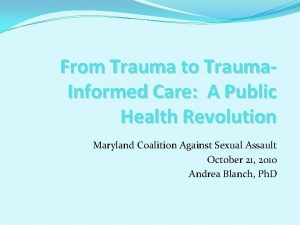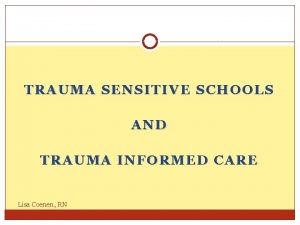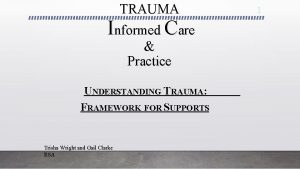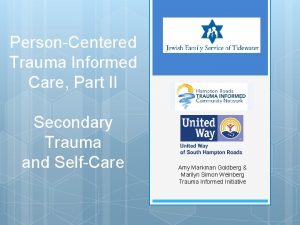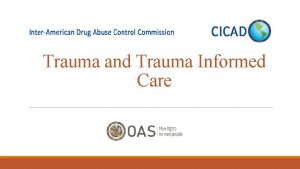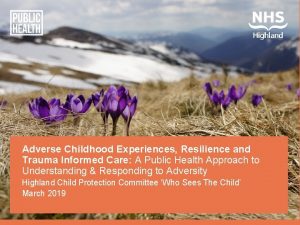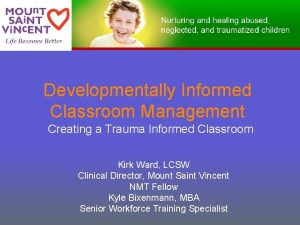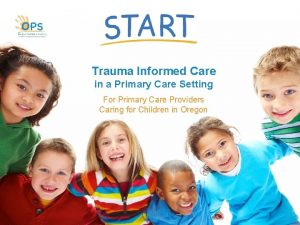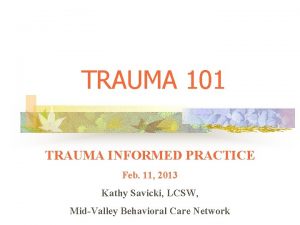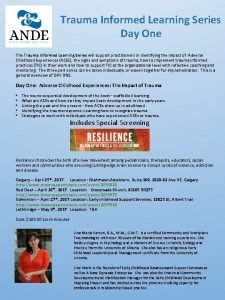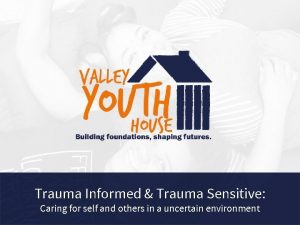Your Experiences Matter Trauma Informed Care How to



















































































- Slides: 83

Your Experiences Matter Trauma Informed Care: How to Integrate TIP into organizational culture May 5 th 2017

Key Concepts • Definitions • Focusing on trauma and resiliency • Universal Precautions approach • Alignment • Everyone plays a role in creating the culture of trauma informed care • Focusing on emotional and physical environments • Trauma is applicable on many levels (client, family, staff, agency, interagency, Intersectoral, societal) • Support for staff in a trauma informed organization • It is a culture shift; it takes time!

Key Concept CONSISTANT DEFINTIONS

What is Trauma? • Trauma can be anything that results from experiences that overwhelm an individual's capacity to cope. • Trauma can result from abuse and neglect, family conflict, poverty, having a life-threatening illness, undergoing repeated and/or painful medical interventions, accidents, witnessing acts of violence, racism, war, grief and loss, intergenerational events, etc. (Adapted from BC MHSU, 2013) • Trauma may happen at the personal, social, and collective/cultural level. (Smye, 2014; Varcoe, 2014).

Resiliency and Recovery • Being able to adapt to stress and adversity • Research has shown it’s not the objective severity of an event that makes it traumatic, but rather the person’s perception of the severity of the event: “Events are not traumatic until we experience them as traumatic”. Retrieved from: resilienceresearch. org

Key Concept PREVALENCE & EFFECTS

Adverse Childhood Experiences

What did the ACE Study find? Some findings…. . • 1 in 4 were exposed to 2 categories of trauma • 1 in 16 were exposed to 4 categories of trauma • 22% were sexually abused as children • 66% of women experienced abuse, violence or family strife • Women were 50% more likely than men to have experienced 5 or more categories • >66% of people in substance abuse treatment report childhood abuse or neglect • 80% of child/adolescent suicide attempts are attributable to Childhood Adverse Experiences


The impact of ACEs on children can manifest in several ways. • Child has difficulty with critical brain functions such as focusing, learning, self-regulation, and decision-making. • Attachment difficulties, including being unable to trust others, empathize, regulate emotions, or manage stress. • Difficulty regulating emotions that may present as appearing withdrawn, expressing a flat affect, or experiencing angry outbursts. • A child may also have difficulty regulating behavior that may present as aggression, over-sexualized behavior, or self-injury. (Anda et al. , 2006; DCF, 2012).

Observable Effects of Trauma Figure taken from N Poole, Building a Trauma-Informed Practice Framework, 2014.

Key Concept UNIVERSAL PRECAUTIONS APPROACH

How Common is Trauma? • 55 -90% of the population has experienced one or more forms of trauma in their lives (CDC & Kaiser Permanente, 19952011; Harris & Fallot, 2009; Farro et al. , 2011). • 76% of Canadian participants identified being exposed to at least 1 traumatic event in their lifetime (Van Ameringen et al. , 2008). • 90% of their 505 clients in a community-based mental health clinic in the US, had been exposed to trauma (Cusack et al. , 2004). • Presume that clients/staff may have a history of traumatic stress and exercise “universal precautions” (Hodas, 2005).

Trauma Informed Care Definition Trauma Informed Care is a strengths-based service delivery approach that is rooted in an understanding of and responsiveness to the impact of trauma, that emphasizes physical, psychological, and emotional safety for both providers and clients (Hopper, Bassuk, & Olivet, 2010).

A Culture Shift: Core Values of Trauma-Informed Care Safety: Ensuring physical and emotional safety Trustworthiness: Maximizing trustworthiness, making tasks clear, and maintaining appropriate boundaries Choice: Prioritizing choice and control Collaboration: Maximizing collaboration and sharing of power Empowerment: Prioritizing client empowerment and skill-building

Key Concepts STAFF SUPPORT

Staff Support, an Essential Component of Trauma Informed Care

The Basic Lesson Staff members—all staff members—can create a setting of, and offer relationships characterized by, safety, trustworthiness, choice, collaboration, and empowerment only when they experience these same factors in the program as a whole. It is unrealistic to expect it to be otherwise.

A Culture Shift: Principles of Trauma-Informed Care • Safety: Ensuring staff physical and emotional safety • Trustworthiness: Maximizing trustworthiness of the system and making staff tasks clear • Choice: Enhancing staff choice and control • Collaboration: Maximizing collaboration and sharing of power with staff • Empowerment: Prioritizing staff empowerment and skill-building

Levels of Work-Related Stress • Organizational: budget constraints; limited leave, supervision, physical resources (space, e. g. ); increased caseloads • Professional: beliefs about empathy, independence, and stoicism; expense of education/consultation • Personal: personal trauma history; ineffective coping attempts; current stressors in personal life. Adapted from Russo, 2007

Burnout, Compassion Fatigue and Vicarious Trauma Burnout • The physical and emotional exhaustion one experiences from low job satisfaction, one feels powerless and overwhelmed. • A profound emotional and physical erosion that takes place gradually when helpers are unable to refuel and regenerate. Compassion Fatigue • It affects your ability to feel empathy for your patients, clients and/or loved ones. • “Must be nice. ” Bitterness toward other coworkers, family and/or friends. Vicarious Trauma • Workers experience a profound shift in their world view, when working with clients that present with trauma. • Stories that clients describe “transfer onto us, ” where we in turn are also traumatized. This happens as a cumulative process. Adapted from Mathieu, 2008

Responses that help! • Organizational : Supervision, time off, education, training, debriefing about client- and work-related stressors, variety (caseload and work tasks), health benefits. • Professional: Understand needs, take time off, new skill development, utilize supervision/consultation, identify strengths, accept reality of stress and strain, sense of humor. • Personal : Be honest about your exposure to emotionally stressful material, attend to inner experience; therapy, transition times, use coping skills common fun and humor, balanced life, spiritual Life. Adapted from Russo, 2007

Structure ADVISORY AND WORKING GROUPS

Trauma Informed Care at the IWK Health Centre VISION A culture that understands trauma and actively creates safe physical and psychological spaces that improve everyone’s experiences. MISSION To embed safety and trustworthiness into everyday interactions, policies and practices. To acknowledge and understand the effects of trauma on people.

Trauma Informed Care At The IWK Health Center Trauma Informed Care Team Advisory Committee Assessment & Treatment Safe & Early Response & Secure Screening Consultants (Community Connections and ARC) Education Research Environments Evaluation Model Psychologically Safe & Healthy Workplace for Staff Community Partnerships Clients and Family

Partnership is Essential • Departments of Health, Education, Justice, Community Service • African Nova Scotian and First Nations Community • Immigrant Services Association of Nova Scotia, Community Justice Society, Akoma, Restorative Inquiry, Laing House, HRSB, Adsum House, Alice House Chisholm Services, Family SOS, Dalhousie University, School Boards and Schools across Nova Scotia including Mi'kmaw Kina'matnewey, Eating Disorders Nova Scotia, Open Door.

Learn from Others Community Connections • Creating Cultures of Trauma-Informed Care (CCTIC) model (Harris and Fallot) • Consultation and Formal Training with Lori Beyer • Utilizing materials: “Trauma-Informed Services Self-assessment and Planning Protocol; ”a “Trauma-Informed Self-assessment Checklist; ” and“Trauma-Informed Services Implementation Form. ” • 5 year plan to become a certified trauma informed care organization. Trauma Centre • Attachment Regulation and Competency Training Experts such as Nancy Poole • BC Women’s and Children's and National Project

Working Group Initiatives • Safe and Secure Environment – Trauma Informed Environmental Checklist • Psychologically Safe and Healthy Workplace – – Debriefing Process Support for Staff - Resource List Staff Mindfulness Sessions Compassion Fatigue • Early Screening and Response – Resources for Patients, Families and Staff – Screening script • Patient and Family Driven Priorities • Upcoming Benchmarking Study

Environmental Checklist

Look Around Your Physical Environment • Examine your physical spaces to ensure they are comfortable, safe and calming • Is wording framed as what you can do vs. what you can’t do? • Are your areas welcoming and friendly with comfortable furniture with maintenance up to date? • Do you have information in areas that is intended to assist staff but may be triggering for students? • Provide culturally appropriate symbols of safety in the physical environment (e. g. if you received Ali training -LGBTQI rainbow flag on an office door, culturally diverse posters, age appropriate) • Artwork- Is the art work displayed calming to most people?

Be Mindful of the Emotional Environment • Create interactions that are kind, calm, reassuring, safe, strengths-based and respectful • Provide relationships which are honest and transparent and provide the student with a developmentally appropriate degree of power and control. The child should understand what is about to happen, have a say and some control. • Ask what helps when you or your child are upset? What was successful in the past? What are the triggers? What can we do? • Continually seeking feedback • Recognizing a coworker may be experiencing difficulty and offering support at the team level and also the organizational level.


Organizational Readiness

EDUCATION PLAN

Education Plan Level 1: Foundational Education and support for EVERYONE Levels 2: Attachment, Regulation and Competency Training For Designated Mental Health and Addictions Staff & Identified Individuals/Teams Levels 3: Specific Trauma Treatment For Designated Mental Health and Addictions Staff & Identified Individuals/Teams(core competencies in development for all levels)

ARC Framework Trauma Experience Integration Competency Executive Functions Self-Development & Identity Regulation Identification Modulation Relational Engagement Attachment Caregiver Affect Management Attunement Effective Response Engagement Psychoeducation Routines & Rituals Blaustein & Kinniburgh, 2010; Kinniburgh & Blaustein, 2005

COMMUNICATION PLAN

Logo •


News Letters

Logo

Key Concept ALIGNMENT WITH OTHER APPROACHES

Complimentary Approaches www. healthcaretoolbox. org

• Complementary School-wide Approaches Restorative approaches: • Requires a paradigm shift in terms of how behavior is viewed by individuals in the environment • Shift focus from a reductionist model to an increasing model • • • Allows school staff to re-interpret the behaviors (or lack thereof) through a lens of adaptive behavior/ • E. g. how does this particular behavior serve the social-emotional needs of the individual based on their experiences Promotion of positive, pro-social skill development • Focus on increasing the development of skill in the areas of regulation, affective responding and competency building Allows for cultural responsiveness- understand the way in which people interpret their world and be responsive to those worldview is shaped differently then their own.

Integration into Daily Practice EVERYONE PLAYS A ROLE IN CREATING A TRAUMA INFORMED ENVIRONMENT

What Can I Do to be “Trauma Informed? ” Knock on Doors Work in Partnership Create Safe Spaces Introduce Yourself & Provide Clear Information Share Information Have Respectful Conversations Promote Engagement & Empowerment “Check In”

Applicability Children’s Health • Recognizing that many medical interventions are traumatizing or retraumatizing for clients and families. • Expanding the ABC’s(airway, breathing, circulation) to DEF’s(Distress, Emotional Support and Family) • Changing processes(OR, team meetings) Women’s and Newborn Health • Recognizing the impact trauma, sexual abuse or domestic violence for instance, can have as women experience prenatal care and child birth. • Asking a client permission to touch them and providing them with rationale before doing an exam. • Examining taking infants into care policies

Applicability Mental Health and Addictions • Creating a safe and secure environment that supports disclosure of trauma. • Recognizing the traumatic impact of seclusion and restraint. • Creating Comfort Rooms • Supporting attachment, regulation and competency Operations and Support Teams • Non-clinical support staff are often the first people clients and families interact with when they enter the health centre • Designing spaces that are trauma informed.

Shifting the culture What does it look like in the school setting?

Supporting Children with Trauma Affect Management Co-Regulation Sensory Modulation/ Mindfulness Attunement Trigger Identification Collaborative Problem Solving Predictability; Structure & Routine Debriefing Attachment Regulation and Competency

Attachment in Schools Provision of physical and emotional care Consistent presence in one’s life Emotional investment in the student Students who experience positive, supportive relationships with teachers/staff results in students who demonstrate greater social competence, have more supportive social networks, display fewer behavior problems, demonstrate higher achievement orientation and academic performance • Teachers/staff mental representations of their own relationships with students predicted students’ academic performance and adjustment in school • •

Student Teacher/Staff Relationship While typically conceived within the context of the parent-child relationship, attachment can be extended to the student-teacher/staff relationship. https: //www. youtube. com/watch? v=ZFmq. KGEcidg

Strategies that often don’t produce positive outcomes • Many consequences • Adult commanding respect from upset student • Assuming upset student is able to remember strategies when stressed/reactive • Assuming the student has cognitive/emotional skills to manage stress/frustration • Ignoring body cues • Taking behaviour personally

What is Regulation? • The ability to take in and manage your internal and external experiences • Multiple forms of regulation grounded in relational security and co-regulation • Like the brain, regulation builds in a generally upward direction • When strategies fail, need to consider other regulatory concerns in order to know how to proceed effectively: Being trauma informed allows for this understanding Dr. Kristen Mc. Leod

Help Increase Affect Regulation • Provide a “safe space” to go when student is overwhelmed • Actively teach Social Skills, problem solving and calming/de-escalation strategies • Remain connected and calm during incident • Reinforce positive choices, affect and respectful behaviours • Do coaching and debriefing first thing in the morning

Structure • Provide clear structure to the day and expections for academic and non-academic success • Limited structure increases insecurity for traumatized student often causing them to actively try to control environment • By actively engaging, consistently responding and positive expectations helps develop security

Environments • Change the environments to minimize stress • Structure activities – ie. One step instructions, taking turn support, planned recess activities • Conduct observations – look for triggers • Set up opportunities for success • Reduce sensory stimulation • Watch for escalation signs – provide break/escape • Provide support/check-ins at the beginning and during lessons to gauge potential frustration

Reinforce Positive Behaviours • Praise publicly and discuss privately • Praise heavily to build self-esteem and self-worth* • Redirect privately and in as calm of voice as possible • *Some students do not react well to praise

Understanding Triggers • A trigger is any stimulus that acts as a reminder of past overwhelming experiences and leads to the same set of behaviours or emotions that originally developed as an attempt to cope with those experiences • When triggered may avoid, withdraw, become overly clingy, freeze, appear “manipulative” or controlling, engage in conflicting approach and avoidance behaviours • Particularly important for caregivers to be attuned to signs that children are becoming overwhelmed (and that they may be as well) • Need to actively assess triggers • Need to watch for signs that a child is becoming distressed and work with the child to help him/her learn those signs.

Trigger Identification – Program Alignment � Unfamiliar adults (Subs) � Emotions of others � New environments � Eye contact � Transitions � Directives/Demands � Loud noises � Changes in routine � Assemblies/Groupings � Visits with natural family � Lines/Queues-order � Sensory sensitivities � Anniversary dates � Praise

During and Episode • Establish safety • Maintain self-regulation • Stay connected, emotionally attuned with good affect, even during incident. Call in help if you start to become unregulated • Focus on triggers/emotions while acknowledging behaviours; not solely focused on behaviour. Staying calm when episodes happen. Be conscious of: • Eye Contact ( keeping in mind cultural norms) • Facial Expression • Tone of Voice • Posture • Gesture • Timing

Creating Connection and Defusing Conflict • • • “I see you need help with…. ” Structure and consistency Setting limits on unacceptable behaviour Time in, not time out Consequences, not punishment Structure choices to remain in control Acknowledge good decisions and choices Support the parents/caregivers Maintain your role

After an Incident Ask: • What were potential triggers? • Did the student understand expectations? • Does the student have the skills to meet the expectations?

Debriefing • Validate the student’s emotions • Be empathetic • Normalize the feelings • Avoid invalidating the student’s emotions • Avoid lecturing or interrogating • Avoid criticizing or blaming • Take the time to debrief • Repair the rupture • Focus on the roots!

Remember • • Expectations need to be realistic Student needs to have the skills to perform the task Practice BEFORE incidents is critical Remember at the time of behaviour the student likely will not remember consequences.

Attunement • Attunement is the capacity for both caregivers and their children to accurately read each others’ cues and respond appropriately. It is achieved through curiosity, empathy, touch, hanging out, eye contact, etc. • Accurate attunement allows caregivers to respond to the emotion underlying the children’s behaviour, rather than simply reacting to the most notable or distressing symptom • Attunement is key for building child’s selfregulation • Dr. Kristen Mc. Leod

Attunement Exercises • Feelings Charades – acting out feeling states; situations; etc • Follow the leader games– including music, movement, mirroring, basic follow-the-leader, Simon Says, etc. • Rhythm-based paired activities • Any Child Led Activity (think 15 minute rule!) • PLAY!!! Any kind of play

Sensory Modulation and Mindfulness • Calms children and brings them into the “here and now” which is safer than the stress or trauma-related thoughts and feelings they may be experiencing. • Calming helps bring their brain activity from hyper aroused to normal.

Sensory Modulation and Mindfulness Practice • • Listening to/Playing music Rhythmic activity/sounds Smudging Stress ball Progressive muscle relaxation Rocker/glider Areas of calm/retreat • Sensory Products • Deep breathing (belly breaths) – bubbles are great • Folding paper airplanes • Ripping up paper • Play dough • Writing/Painting • Tumble Play

Strategies • If you practice mindfulness within the classroom/school setting-it may need to be adapted in the following manner: • Focus on the sounds outside of the individual • Externalization of focus can minimize fear associated with internal phenomenon • Focus on observation of an object • Hand-held object • Option to close eyes or to focus on spot ahead of them • • Reduce fear of possible flashbacks, dissociation Minimize likelihood of “staring” complaints

Maximo Go noodle https: //youtu. be/8 Yki. Llqmlw 8

Use Physical Breaks • Body breaks • Brief physical activities • Deep breathing

Trauma Informed Schools • Commitment to identify and address trauma early • Seek to understand the connection between presenting symptoms and behaviors and a person’s trauma history • Effective interventions by those who understand trauma to promote healing and post traumatic growth • Cross system collaboration and cooperation • Culturally competent practices • Tools and training to help systems effectively identify and help those affected by childhood trauma • Trauma informed policies that support and promote all these efforts(discipline policy, absenteeism)

Sustainability Plan

Sustainability Plan • Team-specific and Community-Based Organization consultations • Facilitator Program/Champions • Orientation/Onboarding Modules • TIC principles incorporated into policies Evaluation • Community Connections Protocol for Certification (Harris and Fallot, 2009) • Annual All Staff Survey (aka Readiness Survey) • Development of Core Competencies • Team-specific TIC Evaluation Checklists

Sustainability Plan Potential Future Initiatives • Human Resources Considerations • Student Training and Research Opportunities • Curriculums for Health Professions

Lessons Learned…. . • Importance of both top down and bottom up support • Balance and flow…. maintaining momentum, managing the floodgate and managing expectations • Dedicated resources (money, people, time) • Competing demands/priorities • Making it relevant and applicable to individual staff • Being role models: modelling trauma informed care • Addressing assumptions…. “I’ve always practiced trauma informed care”… • If you ask people about compassion fatigue and burnout, you have to be ready and able to respond.

RESOURCES

Training Modules Madison Metropolitan School District • • Module 1 - Trauma Informed Practices: Module 1 - Introduction to Trauma - 11: 17 minutes https: //www. youtube. com/watch? v=ela. LV_b 8 FXw Module 2 - Trauma Informed Practices: Module 2 - A Sense of Safety - 10: 48 Minutes https: //www. youtube. com/watch? v=l. Jpaf. A 1 G 148 Module 3 - Trauma Informed Practices: Module 3 - Creating Safety - 10: 39 minutes https: //www. youtube. com/watch? v=YQo. QS 4 RFJRQ Module 4 - Trauma Informed Practices: Module 4 - Importance of Relationships - 14: 13 https: //www. youtube. com/watch? v=XKlm. Zobb. GIw Module 5 - Trauma Informed Practices: Module 5 - Trauma Affects Brain Development 12: 35 minutes https: //www. youtube. com/watch? v=5 LZJEre. Vl. Co Module 6 - Trauma Informed Practices: Module 6 - Self-Regulation and Learning - 11: 48 minutes https: //www. youtube. com/watch? v=Gw. Mr. DDHd. ZIA Module 7 - Trauma Informed Practices: Module 7 - Empowerment - 7: 42 minutes https: //www. youtube. com/watch? v=-tyx. Cb. K 360 Q Module 8 - Trauma Informed Practices: Module 8 - Taking Care of Ourselves - 9: 54 minutes https: //www. youtube. com/watch? v=y. L 51 Vu. Tku. I 0 Module 9 - Trauma Informed Practices: Module 9 - Trauma-Informed Disciplinary Practices - 8: 54 minutes https: //www. youtube. com/watch? v=-gh. T 4 T 2 y. FQs




Holly Murphy, MN, RN BSc. N, CPMHN(c) Clinical Project Leader for Trauma Informed Care Holly. murphy@iwk. nshealth. ca (902)470 -6302
 4 r's trauma informed care
4 r's trauma informed care Trauma informed care lgbtq
Trauma informed care lgbtq 4 r's trauma informed care
4 r's trauma informed care Trauma-informed care cheat sheet
Trauma-informed care cheat sheet 4 r's trauma informed care
4 r's trauma informed care Family enhancement center
Family enhancement center Tina champagne trauma informed care
Tina champagne trauma informed care Trauma informed practice
Trauma informed practice Trauma informed icebreakers
Trauma informed icebreakers Trauma informed care for foster youth
Trauma informed care for foster youth Trauma informed workplace
Trauma informed workplace Trauma-informed questions for clients
Trauma-informed questions for clients Trauma informed legal advocacy
Trauma informed legal advocacy Kobtion
Kobtion Trauma informed advising
Trauma informed advising Acessexual
Acessexual Trauma informed practice
Trauma informed practice Trauma informed physical environment
Trauma informed physical environment Trauma informed practice
Trauma informed practice Primary, secondary, tertiary care
Primary, secondary, tertiary care Dshs uncompensated trauma care application
Dshs uncompensated trauma care application Early total care in trauma
Early total care in trauma Gerunde
Gerunde Traveling might satisfy your desire for new experiences
Traveling might satisfy your desire for new experiences Infinitive as indirect object
Infinitive as indirect object Traveling might satisfy your desire for new experiences.
Traveling might satisfy your desire for new experiences. Section 1 composition of matter
Section 1 composition of matter Grey matter of nervous system
Grey matter of nervous system Composition of matter section 1
Composition of matter section 1 Chapter 2 section 1 classifying matter answers
Chapter 2 section 1 classifying matter answers Dural septa
Dural septa Composition of matter section 1
Composition of matter section 1 Gray matter and white matter
Gray matter and white matter What does grey matter do
What does grey matter do Ecological succession
Ecological succession Give us your hungry your tired your poor
Give us your hungry your tired your poor Informed action
Informed action Stakeholder mapping exercise
Stakeholder mapping exercise Solace american pie
Solace american pie Stakeholder mapping
Stakeholder mapping 22power dot com
22power dot com Informed (heuristic) search strategies
Informed (heuristic) search strategies An informed guess or assumption about a certain problem
An informed guess or assumption about a certain problem Informed and uninformed search
Informed and uninformed search Informed user of information systems
Informed user of information systems Statistics informed decisions using data 5th edition pdf
Statistics informed decisions using data 5th edition pdf Psychologically informed environments
Psychologically informed environments Psychologically informed environments
Psychologically informed environments Dasar hukum informed consent
Dasar hukum informed consent Informed search example
Informed search example Best first search in ai
Best first search in ai Http informed delivery usps
Http informed delivery usps Informed delivery multiple residents
Informed delivery multiple residents Ethical principles governing informed consent process
Ethical principles governing informed consent process Blind search algorithm
Blind search algorithm What is an informed personal response
What is an informed personal response Psychologically informed environment
Psychologically informed environment What philosophical ideas informed the founding generation?
What philosophical ideas informed the founding generation? Informed delivery campaigns
Informed delivery campaigns Advantages of informed consent
Advantages of informed consent Informed user of information systems
Informed user of information systems Informed decision making skills
Informed decision making skills What is the other name of informed search strategy?
What is the other name of informed search strategy? Image search
Image search Slbet portugal
Slbet portugal Broad informed consent
Broad informed consent Informed search
Informed search Informed consent brochure
Informed consent brochure Uninformed and informed search
Uninformed and informed search Essential elements of informed consent
Essential elements of informed consent Duty of care outcome care certificate
Duty of care outcome care certificate Magnetii atrag fierul
Magnetii atrag fierul Palliative care vs hospice care
Palliative care vs hospice care Animalele se pot inmulti prin
Animalele se pot inmulti prin Care sunt simturile prin care sunt evocate
Care sunt simturile prin care sunt evocate Standard 13 care certificate answers
Standard 13 care certificate answers Hip fracture clinical care standard
Hip fracture clinical care standard Health and social care values unit 2
Health and social care values unit 2 All customers are served from a single focal serving point
All customers are served from a single focal serving point What is contrived experiences
What is contrived experiences Cs_rs11-iiia-1
Cs_rs11-iiia-1 An account of the personal experiences of an author
An account of the personal experiences of an author What are positive subjective experiences
What are positive subjective experiences Chapter 20 guiding storytelling experiences
Chapter 20 guiding storytelling experiences
